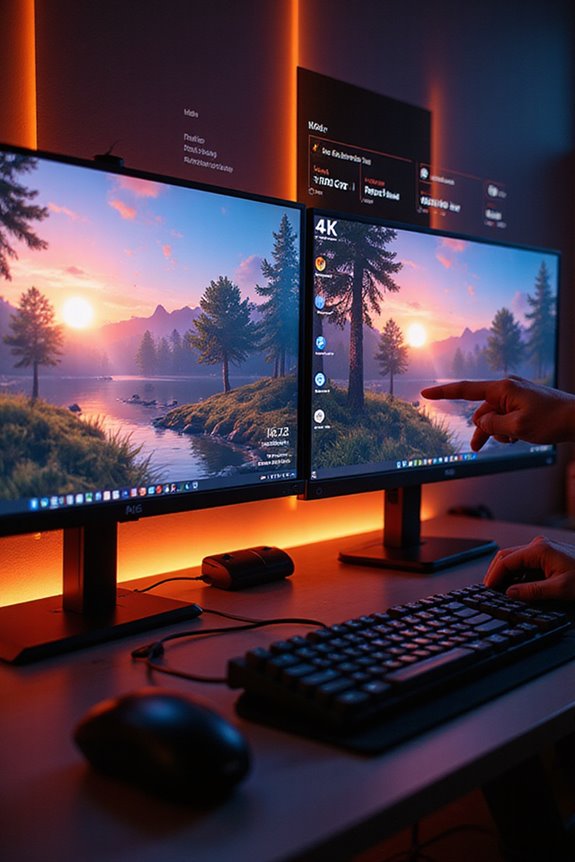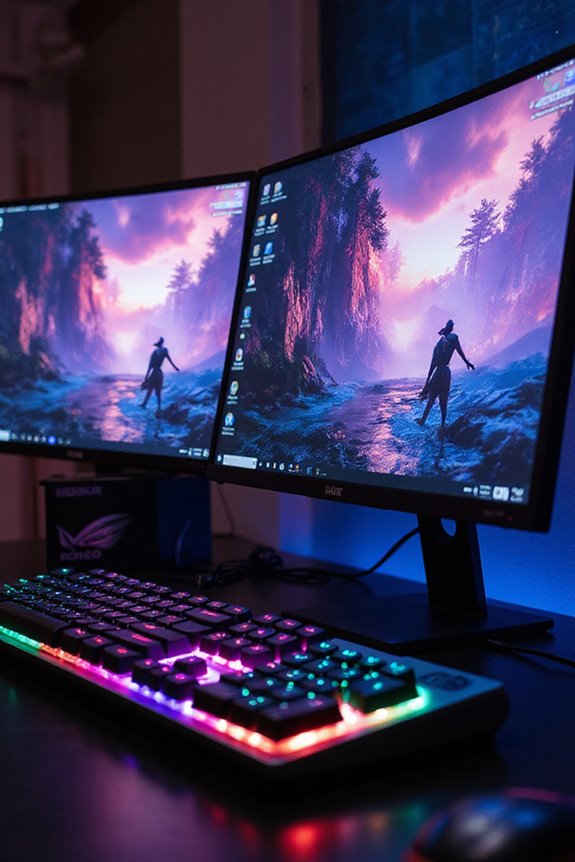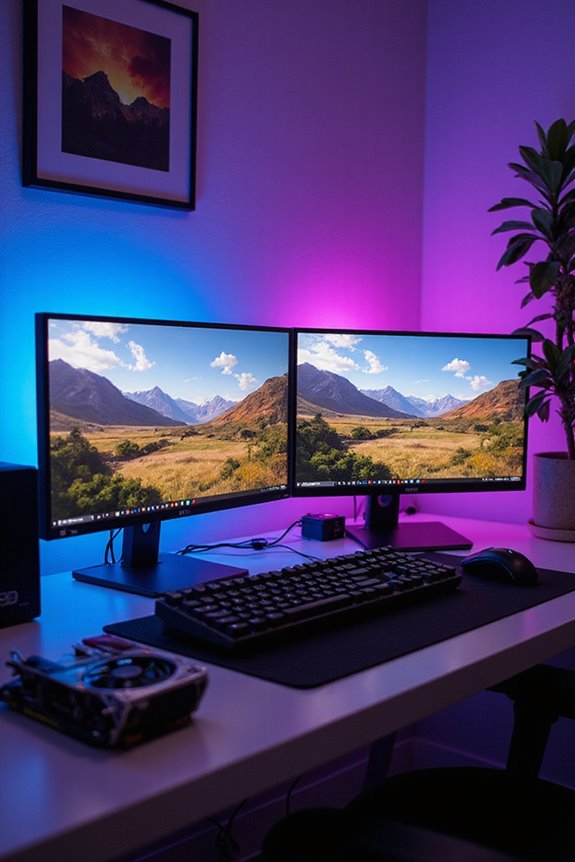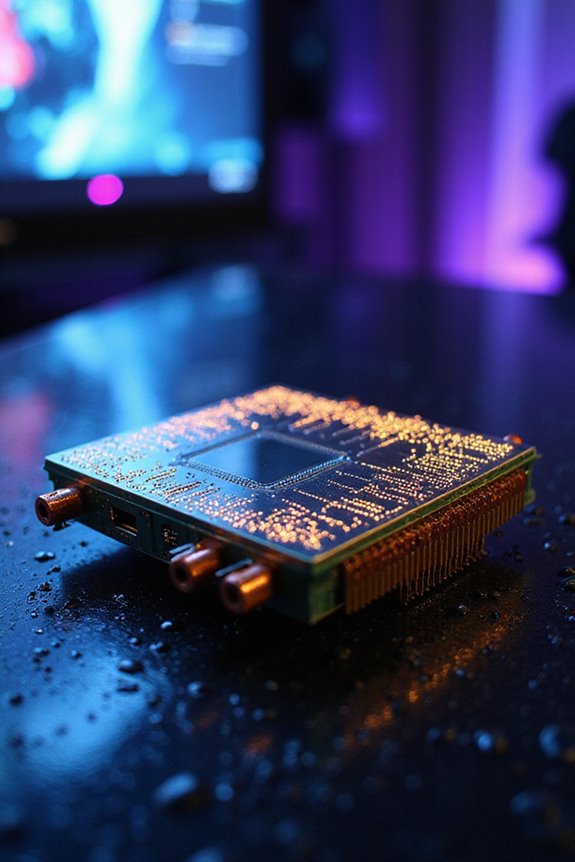If you’re serious about gaming, a 4K monitor can really enhance your experience. With a resolution of 3840 x 2160 pixels, you’ll enjoy sharper images and vibrant colors. It’s ideal for spotting enemies and immersing yourself in detailed environments. Plus, models with a 144Hz refresh rate and low response times make fast-paced action smoother. Just remember, you’ll need a powerful GPU to fully benefit from 4K. Stick around, and you’ll discover more about choosing the right monitor.
Key Takeaways
- A 4K gaming monitor enhances visual clarity with sharper images, making details more pronounced in games.
- If you have a powerful graphics card, a 4K monitor can fully realize your gaming experience.
- Larger screens provide a cinematic feel, increasing immersion in gameplay.
- High refresh rates (120Hz or 144Hz) in 4K monitors reduce motion blur for fast-paced gaming.
- Prices vary significantly, but sales and newer models can make 4K gaming more accessible.
Understanding 4K Resolution and Its Benefits
When it comes to gaming and visual media, understanding 4K resolution is pretty essential. The most common 4K formats, like 3840 x 2160 for UHD, boast around eight million pixels—impressive, right? This pixel density means sharper images, bringing games and movies to life in ways that lower resolutions can’t match. Plus, the DCI 4K format supports the P3 color gamut, delivering more vibrant colors.
While the clarity is fantastic, it does require robust hardware to truly enjoy. You’ll need a powerful graphics card and a monitor that can handle all those pixels without breaking a sweat. So, if you’re considering a 4K monitor, just know it’s not just about size; it’s about sharpness and color accuracy too.
Enhanced Gaming Experience With 4K Monitors

While diving into the world of 4K gaming monitors, I can’t help but notice how they truly elevate the gaming experience. The ultra-high resolution provides visual immersion, making every detail pop, from textures to colors. With sharper images, I find it easier to spot enemies lurking in the shadows or navigate complex terrains, gaining that competitive advantage.
Larger screens create a cinematic feel, pulling me deeper into the game world. And let’s not forget the improved color accuracy, which makes everything look more lifelike. Sure, you’ll need a powerful graphics card to release the full potential, but when you do, the enhanced detail transforms ordinary gameplay into something extraordinary.
Key Technical Specifications to Consider

Choosing the right 4K gaming monitor can feel overwhelming, especially with the multitude of specifications to evaluate. One of the first things I consider is panel selection; IPS panels are great for their color accuracy and wide viewing angles. The resolution impact is significant too—3840 x 2160 pixels gives you stunning detail, four times that of Full HD.
Don’t overlook the refresh rate; while 60Hz is standard, models up to 144Hz offer smoother gameplay. A low response time of 1ms is essential for fast-paced action. And if you want vibrant visuals, look for HDR support of HDR400 or higher. Each feature plays a role in enhancing your gaming experience, so prioritize what matters most to you.
Gaming Performance Enhancements for 4K

4K gaming monitors bring a level of visual clarity that can really enhance your gaming experience. With stunning textures and environments in AAA titles, you’ll feel immersed like never before. However, there are performance challenges; achieving high frame rates at 4K requires powerful GPUs like the NVIDIA GeForce RTX 3080. Higher refresh rates, such as 120Hz or 144Hz, help reduce motion blur, making fast-paced action smoother and giving you a tactical advantage over opponents. IPS and VA panels offer vibrant colors and contrast, while TN panels focus on speed. While the details may be breathtaking, it’s essential to optimize your settings to maintain smooth performance and enjoy the full potential of your 4K gaming monitor.
Cost and Availability of 4K Gaming Monitors

When you’re considering a 4K gaming monitor, it’s important to understand that the cost can really vary depending on the features you’re after. I’ve seen prices range from around $400 for basic models to over $1,000 for high-end options like the Alienware 32 4K QD-OLED. If you’re savvy, you can catch some great sales—like the Samsung Odyssey Neo G7 slashed from $999.99 to $569.99.
Widespread availability means you can find these monitors almost anywhere, especially online at retailers like Dell. As market trends shift, I’ve noticed price reductions on newer models, making it easier to jump into 4K gaming without breaking the bank. Just remember, a higher price often means better performance and features.
Choosing the Right Panel Type
Panel types can make a significant difference in your gaming experience, so it’s worth diving into the options. I often find myself weighing a panel comparison between TN, IPS, VA, and OLED. TN panels are fast and affordable, but their color accuracy leaves a lot to be desired. IPS panels shine with great color accuracy and wide viewing angles, making them perfect for both gaming and design. VA panels offer impressive contrast but can struggle with viewing angles. Then there’s OLED, which delivers stunning color accuracy and contrast, though it typically comes with a higher price tag. Each type has its strengths and weaknesses, and choosing the right one can elevate your gaming experience beautifully.
Importance of Refresh Rate and Response Time
While it might seem like a minor detail, the refresh rate and response time of a gaming monitor can greatly impact your overall experience. Higher refresh rates, like 144Hz or 240Hz, offer refresh rate benefits by providing smoother motion and reducing motion blur in fast-paced games. On the flip side, response time is important for minimizing ghosting during those intense moments. Monitors with a 1ms response time can make a noticeable difference, ensuring clearer visuals. Plus, technologies like G-Sync and FreeSync help sync frame rates with refresh rates, preventing tearing. Ultimately, finding that sweet spot with a high refresh rate and fast response time can elevate your gaming, making every frame count and every moment immersive.
Balancing Budget and Performance Needs
Finding the right balance between budget and performance needs can feel like an intimidating task, especially with so many options on the market. If you’re on a tighter budget, you might consider 1440p monitors for their excellent performance trade-offs, usually priced between $180 and $230. They often deliver higher refresh rates, which can be a game-changer for fast-paced gaming.
On the other hand, budget 4K monitors start around $240, offering decent quality, but you might sacrifice advanced features like HDR or high refresh rates. If you can stretch your budget to $400, you’ll find better 4K monitors that enhance your gaming experience. Ultimately, it’s about weighing those budget considerations against what you truly need for your setup.
Frequently Asked Questions
Can I Use a 4K Monitor for Non-Gaming Activities?
I love using my 4K monitor for non-gaming activities. The 4K productivity benefits are incredible, especially for 4K content creation. It makes everything from editing photos to managing spreadsheets so much easier and more enjoyable.
Will a 4K Monitor Improve My Console Gaming Experience?
Absolutely, a 4K monitor can transform your console gaming experience. With stunning 4K graphics and solid console compatibility, I’ve noticed incredible detail and immersion that really enhances the overall gameplay. You’ll love it!
What Size 4K Monitor Is Best for Gaming?
Funny coincidence, I’ve been pondering monitor size for my gaming setup too! I found that a 32-inch 4K monitor strikes the perfect balance between immersion and clarity, making my gaming experience so much more enjoyable.
Do I Need a Specific Cable for 4K Gaming?
When gaming at 4K, I always check the HDMI specifications or DisplayPort requirements. It’s essential to guarantee I’ve got the right cables, like HDMI 2.1 or DisplayPort 1.4, for the best experience.
Is 4K Gaming Worth It for Casual Players?
Honestly, for casual gaming, 4K might not be worth it. I find the performance trade-offs can be significant, especially with costs and hardware. A solid 1440p setup often gives a better balance for my enjoyment.





